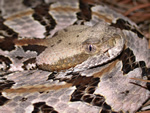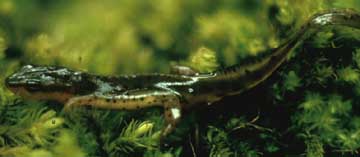

Copperhead (venomous)
Unfortunately, there is no simple way to distinguish between a venomous snake and a non-venomous snake. The best possible advice one can follow is that any snake that cannot be positively identified as harmless should not be handled. Many people believe that all snakes with triangular-shaped heads are potentially venomous. Although all pit vipers (rattlesnakes, copperheads, cottonmouths) in the eastern United States have broad triangular heads, so do some non-venomous species such as
 |
 |
Copperhead (venomous) |
Timber Rattlesnake (venomous) |
photo credit: RW VanDevender |
water snakes (Nerodia).
In addition, a nontriangular head does not signify the absence of venom: the
two species of coral snakes in the United States, both venomous, have slender
heads with little distinction between head and neck. Another over generalization
is that venomous snakes have elliptical pupils, whereas all harmless snakes
have round pupils; however venomous coral snakes also have round pupils.
Unfortunately, no single rule separates all venomous species from all of the
harmless ones.
Do harmless snakes ever interbreed with dangerous ones?
Although it is sometimes possible
for similar species to interbreed in nature, such events are extremely rare.
The offspring resulting from such an interbreeding event are usually infertile.
There is no documented account of a venomous snake species interbreeding with
a non-venomous species.
Can the bite from a non-venomous snake such as a kingsnake or racer make a person sick?
The bite from a non-venomous snake is almost always harmless. Most bites from non-venomous snakes result in very little lasting pain. In addition, if the bite is cleaned properly (with soap and water) and at frequent intervals, even the chance of infection is very low.
What do I do if I'm bitten by a venomous snake?
This inquiry is a very serious one and therefore requires a detailed response. Although snakebites are uncommon, a few bites occur every year in the Carolinas. The proper response to a venomous snakebite involves both what to do and what not to do. Unless a snake is venomous, treatment is not usually necessary (see snake misconceptions) . The following is a list of what to do and what not to do if bitten by a venomous snake.
The DOs
![]() Try to identify the offending snake if you can do so easily without putting
yourself at risk or wasting valuable time.
Try to identify the offending snake if you can do so easily without putting
yourself at risk or wasting valuable time.
![]() Try to stay calm!
Try to stay calm!
The DON'Ts
![]() Do not eat or drink anything, including alcoholic beverages or medicine.
Do not eat or drink anything, including alcoholic beverages or medicine.
![]() Do not run or engage in strenuous physical activity.
Do not run or engage in strenuous physical activity.
![]() Do not cut or incise bite marks with a blade.
Do not cut or incise bite marks with a blade.
![]() Do not apply a constrictive tourniquet.
Do not apply a constrictive tourniquet.
![]() Do not use a stun gun or other electrical shock.
Do not use a stun gun or other electrical shock.
![]() Do not freeze or apply extreme cold to the area of the bite.
Do not freeze or apply extreme cold to the area of the bite.
What can I put around my yard to repel snakes?
There is no foolproof way to prevent
snakes from entering one's property. Some products are sold with claims
of deterring snakes, however the effectiveness of these products remains to
be proven. The repellent products that are most commonly advertised contain
either sulfur or naphthalene (mothballs). However, the amount of product
required to be effective against snakes would make the treated area intolerable
for almost everything else, including people.
| What
is the difference between a salamander and a newt?
A newt is actually a salamander belonging to the family
Salamandridae.
The reason why newts are most often thought of as being different from
other salamanders is that they have three distinct life stages.
Similar to many salamanders, newts begin their development in the water.
However, next they metamorphose into a reproductively immature terrestrial
form called an "eft." Finally, they return to the water where they
regain a tail fin and reach full sexual maturity. |
Red-Spotted Newt
(Notophthalmus viridescens)

|
|
What is the difference between a frog and a toad? When most people think of frogs, they think of animals that are primarily aquatic with moist skin. Another characteristic that often comes to mind is the presence of long back legs for leaping. When people think of toads, they think of amphibians with dry bumpy skin that spend most of their time on land. Toads are usually thought of as having short back legs that allow for hopping. In reality, there are over twenty families of frogs and toads. The family Ranidae, is commonly referred to as containing the "true frogs." Similarly, the family Bufonidae is usually cited as containing the representative toads. However, as one can imagine, the distinction between frogs and toads breaks down once one begins to consider individuals from all of the other families.
Return to Amphibians and Reptiles of North Carolina
|